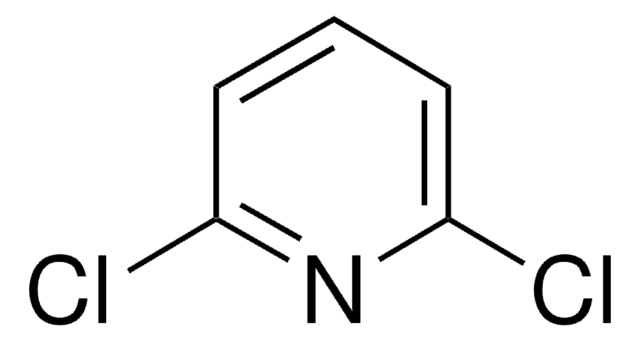456543
2,6-Dichloropyridine-4-carboxylic acid
98%
Sinonimo/i:
2,6-Dichloroisonicotinic acid
Autenticatiper visualizzare i prezzi riservati alla tua organizzazione & contrattuali
About This Item
Formula empirica (notazione di Hill):
C6H3Cl2NO2
Numero CAS:
Peso molecolare:
192.00
Numero MDL:
Codice UNSPSC:
12352100
ID PubChem:
NACRES:
NA.22
Prodotti consigliati
Livello qualitativo
Saggio
98%
Stato
solid
Punto di fusione
209-212 °C (lit.)
Gruppo funzionale
carboxylic acid
chloro
Stringa SMILE
OC(=O)c1cc(Cl)nc(Cl)c1
InChI
1S/C6H3Cl2NO2/c7-4-1-3(6(10)11)2-5(8)9-4/h1-2H,(H,10,11)
SQSYNRCXIZHKAI-UHFFFAOYSA-N
Categorie correlate
Avvertenze
Warning
Indicazioni di pericolo
Consigli di prudenza
Classi di pericolo
Eye Irrit. 2 - Skin Irrit. 2 - STOT SE 3
Organi bersaglio
Respiratory system
Codice della classe di stoccaggio
11 - Combustible Solids
Classe di pericolosità dell'acqua (WGK)
WGK 3
Punto d’infiammabilità (°F)
Not applicable
Punto d’infiammabilità (°C)
Not applicable
Dispositivi di protezione individuale
dust mask type N95 (US), Eyeshields, Gloves
Scegli una delle versioni più recenti:
Possiedi già questo prodotto?
I documenti relativi ai prodotti acquistati recentemente sono disponibili nell’Archivio dei documenti.
M Rauscher et al.
The Plant journal : for cell and molecular biology, 19(6), 625-633 (1999-11-26)
Treatment of broad bean leaves with salicylic acid (SA) or 2, 6-dichloro-isonicotinic acid (DCINA) induces resistance against the rust fungus Uromyces fabae resulting in reduced rust pustule density. Light-microscopy studies showed that in induced resistant plants the rust fungus is
Jan M Lucht et al.
Nature genetics, 30(3), 311-314 (2002-02-12)
Evolution is based on genetic variability and subsequent phenotypic selection. Mechanisms that modulate the rate of mutation according to environmental cues, and thus control the balance between genetic stability and flexibility, might provide a distinct evolutionary advantage. Stress-induced mutations stimulated
Z H He et al.
Plant molecular biology, 39(6), 1189-1196 (1999-06-25)
WAK1 (wall-associated kinase 1) is a cytoplasmic serine/threonine kinase that spans the plasma membrane and extends into the extracellular region to bind tightly to the cell wall. The Wak1 gene was mapped and found to lie in a tight cluster
Han Suk Kim et al.
The Plant cell, 14(7), 1469-1482 (2002-07-18)
One of several induced defense responses in plants is systemic acquired resistance (SAR), which is regulated by salicylic acid and in Arabidopsis by the NIM1/NPR1 protein. To identify additional components of the SAR pathway or other genes that regulate SAR-independent
Proton Mobility in 2-Substituted 1, 3-Dichlorobenzenes:?ortho? or ?meta? Metalation?
Schlosser M, et al.
European Journal of Organic Chemistry, 19, 4398-4404 (2006)
Il team dei nostri ricercatori vanta grande esperienza in tutte le aree della ricerca quali Life Science, scienza dei materiali, sintesi chimica, cromatografia, discipline analitiche, ecc..
Contatta l'Assistenza Tecnica.








